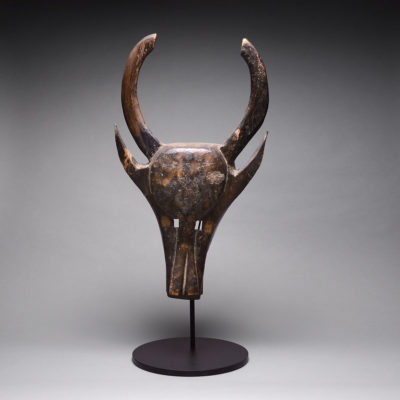
| SKU | PF.3624 |
|---|---|
| Circa | 20th Century AD |
| Dimensions | 27″ (68.6cm) high x 15.5″ (39.4cm) wide |
| Medium | Wood |
| Origin | Central Mali |
| Gallery Location | USA |
This imposing buffalo (?) mask was made by the Bambara/Bamana people of Mali, and was an attribute of one of their secret societies. It is a very accomplished piece, with a large, rounded head running into an elongated snout, and framed with incurved horns and diagonally- projecting ears. The surface detailing is intriguing, with a central roundel on the forehead narrowing at the apex of the nose then widening towards the snout (where it is bifurcated), lending a more three-dimensional look to the piece. The eyes are small squares tucked into either side of the constriction. The mouth is agape. The surface is smoothed and quite glossy with usage, which is unusual for these pieces, which are usually matt and decorated with organic materials (see below).
The Bambara/Bamana is one of the largest groups in Mali (about 2.5 million) and lives in a savannah grassland area that contrasts strongly with the Dogon heartland. Their linguistic heritage indicates that they are part of the Mande group, although their origins go back perhaps as far as 1500 BC in the present-day Sahara (i.e. Tichitt). They gave rise to the Bozo, who founded Djenne in an area subsequently overrun by the Soninke Mande (<1100 AD). Their last empire – the Mande-speaking Songhai – dissolved in the 1600s, and many Mande speakers spread out along the Nigeria River Basin. The Bamana empire arose from these remnant populations in around 1740. The height of its imperial strength was reached in the 1780s under the rule of N’golo Diarra, who expanded their territory considerably. However, their influence waned in the 19th century and the empire fell to the French in 1892. Their society is Mande-like overall, with patrilineal descent and a nobility/vassal caste system that is further divided into numerous subvariants of the Bamana state, including the Jula (traders), Fula (cattle herding), Bozo (essentially endentured slaves, carrying out menial jobs) and Maraka (rich merchant class). Unusual jobs are rewarded with caste status, notably historians (Griot), while those whose ancestors were originally slaves to the Bamana (Jongo) have inherited their antecedents’ low status. Age, sex and occupation groups are classed by “ton” – societies that reflect their social importance (age- or sex-related) or work (i.e. hunters, farmers). This complex history is echoed in the systematics of indigenous art traditions. There are four main mask forms, related to the n’tomo, Komo, Nama and Kore societies. Other forms include the famous Chi- Wara headcrest, which was used to encourage good harvests. Heavily encrusted zoomorphic “Boli” figures are also known, along with everyday items include iron staffs, wooden puppets and equestrian figures, which double as accessories for male initiation ceremonies. Their anthropomorphic door locks are especially well- known, and are given to women as wedding presents as they imply fertility with a vertical female body and the “male” bar which slides back and forth. Masquerade conventions are extremely complex. This model pertains to the Komo, one of the three power societies in Bamana culture (the others are the Kono and Nama societies) which was a secret elder society of priests and elders who were concerned with the guardianship of tradition, judicial customs and rites of passage. These zoomorphic masks were usually made in an elongated manner, then adorned with organic objects such as feathers, textiles, bones, cordage and raffia. The masks were worn, usually with an all-covering costume, on top of the head, and the displays were intended to captivate and intimidate onlookers into social obedience. The society headdress (komo-kun) is worn for a dance to invoke nyama, the force that activates the universe. This is an intriguing piece of African art.
Login to view price
Sign-up to receive the latest Wedding Estates news and promotions!

